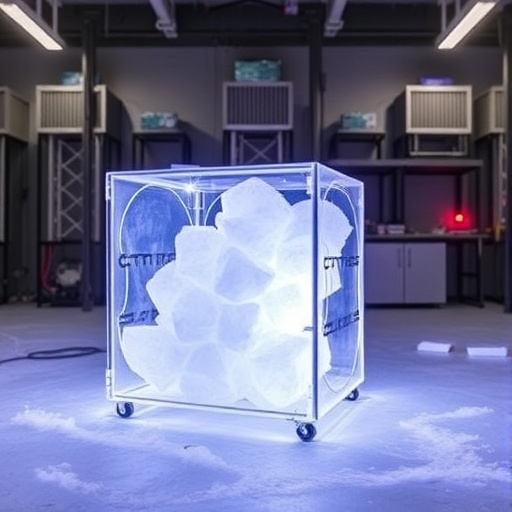In a groundbreaking advancement at the frontier of quantum physics, a collaborative research effort between ETH Zurich and TU Wien has unveiled a remarkable phenomenon: the ability to isolate and emphasize the quantum mechanical behavior of rotational vibrations in nanoparticles at room temperature. This finding challenges longstanding assumptions that quantum effects in relatively large particles require cooling to near absolute zero, offering new pathways for exploring and harnessing quantum phenomena in everyday conditions.
At its core, quantum physics describes the fundamental behavior of matter and energy at atomic and subatomic scales. Traditionally, observing quantum effects in objects larger than individual atoms or molecules has been hampered by environmental interference and thermal noise, which tend to obscure or destroy delicate quantum states. The new experiments focus on glass nanoparticles roughly one hundred nanometers in diameter—large enough to be visible under certain microscopes, yet minuscule compared to macroscopic objects—pushing the boundaries of quantum mechanics into the mesoscopic realm.
One of the central challenges in observing quantum phenomena in nanoparticles is the isolation of specific degrees of freedom from the surrounding environment. Particles in everyday settings incessantly undergo vibrational and rotational motions influenced by thermal energy. Usually, these motions conform to classical physics, with continuous values allowed in their amplitude and energy. Conversely, quantum mechanics dictates discrete energy states and oscillations known as quanta, forbidding intermediate levels between these quantized states. For vibrational motions, these quantized states include a fundamental “ground state” (the lowest possible energy level) and a ladder of excited states with incrementally higher energies.
Carlos Gonzalez-Ballestero, a theoretical physicist at TU Wien, elaborates on this quantum restriction: “Unlike a classical pendulum that can swing at any arbitrary angle and speed, quantum oscillators exhibit discrete vibrational states. The particle’s motion can be a superposition of these quantized states, yet transitions occur only between distinct energy levels—this characteristic is a hallmark of quantum mechanics.” Achieving and demonstrating this quantum purity in a nanoparticle’s vibrational or rotational degrees of freedom has been a formidable experimental task.
Historically, researchers have leveraged cryogenic techniques to cool nanoparticles close to absolute zero, thereby damping out thermal motion and enhancing quantum coherence. Energy losses due to environmental noise are minimized this way, allowing apparently classical objects to display quantum behavior. However, maintaining such extreme and technically challenging conditions limits practical applications and the study of quantum mechanics in realistic environments.
The ETH Zurich and TU Wien research teams pioneered a novel approach that removes the necessity of ultra-low thermal environments. Their work focuses on the rotational degrees of freedom of slightly elliptical glass nanoparticles trapped in electromagnetic fields. When confined in a laser-generated optical trap, the asymmetrical shape causes these particles to spin. Using carefully tuned laser beams and meticulously positioned mirrors, the researchers were able to manipulate the rotational energy of these nanoparticles with unprecedented precision.
Through an intricate optomechanical feedback system, the laser light can both impart energy to the particle or siphon it away. By optimally configuring this feedback, more energy is systematically extracted from the particle’s rotational motion than added, effectively “cooling” the rotation into its quantum ground state despite the particle itself remaining thermally hot. This decoupling is a monumental achievement, as it demonstrates that a specific motion within a thermally active system can be frozen into quantum coherence while the particle’s internal temperature remains high.
Importantly, laser quantum noise—random fluctuations of the light field—posed theoretical and experimental challenges that the team had to meticulously understand and control. Quantum noise typically limits measurement sensitivity and the precision of energy exchange in optomechanical systems. Successfully mitigating this noise was critical to achieving the high purity of quantum states in the rotational vibration of these nanoparticles.
The implications of this achievement are multidimensional. For one, it paves the way to study quantum mechanics in a stable and scalable fashion without the expensive infrastructure required for cryogenic cooling. This opens innovative avenues in quantum optomechanics where room-temperature quantum states could be exploited for sensors, quantum information processing, or tests of quantum foundations. Furthermore, the ability to isolate and observe quantum rotational motions extends the toolkit for investigating quantum behavior beyond simple vibrational modes, encompassing rotational dynamics and angular momentum in mesoscopic particles.
By demonstrating that quantum purity in the rotation of nanoparticles can surpass previous records at room temperature, the research redefines long-held beliefs about the constraints imposed by thermal noise and environmental decoherence. “We can now study and utilize the quantum properties of objects in ways previously deemed impossible without extreme cooling,” states Gonzalez-Ballestero, underscoring the technological practicality and scientific significance of the discovery.
Such findings could revolutionize how future quantum technologies are developed, potentially integrating quantum sensors or communication devices into environments where maintaining extreme cryogenic conditions is impractical or uneconomical. The approach might also lead to novel experimental platforms for verifying quantum theories and exploring transitions between classical and quantum realms.
In broader terms, this breakthrough emphasizes the nuanced understanding required when examining quantum systems that cannot simply be treated as uniformly cooled or isolated. Different degrees of freedom—such as internal thermal vibrations versus rotational modes—can manifest quantum characteristics independently under tailored conditions. This refined perspective enriches our conceptual framework of quantum systems and enhances experimental strategies to manipulate and probe them.
Ultimately, the research heralds a new era in quantum optomechanics, where controlling and observing quantum states at room temperature becomes a tangible reality. This progress invigorates the quest to harness quantum phenomena in real-world technologies and deepens our fundamental grasp of the quantum-classical boundary, motivating a renewed exploration of the principles that govern our universe at its most elemental levels.
Subject of Research: Not applicable
Article Title: High-purity quantum optomechanics at room temperature
News Publication Date: 6-Aug-2025
Web References: https://dx.doi.org/10.1038/s41567-025-02976-9
Image Credits: Lorenzo Dania (ETHZ)
Keywords
Quantum physics, nanoparticles, optomechanics, quantum ground state, rotational vibrations, laser cooling, room temperature quantum states, mesoscopic quantum behavior, quantum noise control, electromagnetic trapping, quantum coherence, ETH Zurich, TU Wien




